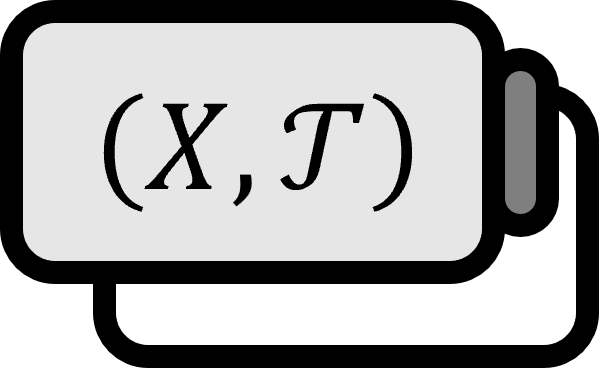Finite Intersection Property
Definition 1
Let’s say topological space is $X$ and $\mathscr{A} \subset \mathscr{P} (X)$. It is said to have the Finite Intersection Property if for all finite subsets $A \subset \mathscr{A}$, $\displaystyle \bigcap A \ne \emptyset$ implies $A$.
Explanation
That $A$ has the f.i.p. means the same as always meeting the following condition for open sets $U_{\alpha} \subset A$: $$ \bigcap_{i=1}^{n} \left( X \setminus U_{i} \right) \ne \emptyset \implies \bigcap_{\alpha \in \forall } \left( X \setminus U_{\alpha} \right) \ne \emptyset $$
Note that this property refers not to a topological space but to a set in general. For example, $\displaystyle \left\{ \left. \left[ 0 , {{1} \over {n}} \right] \ \right| \ n \in \mathbb{N} \right\}$ can be said to have the f.i.p. without specifying any topology.
The following theorem is useful because it gives a necessary and sufficient condition for compactness, but writing it out is verbose and the proof very difficult to understand. It’s natural to feel discouraged, but compactness is inherently tough, so let it be.
Theorem
For $X$ to be compact, the necessary and sufficient condition is that it has the f.i.p. for all closed $A_{\alpha} \subset X$ such that $\displaystyle \bigcap_{\alpha \in \forall} A_{\alpha} \ne \emptyset$.
Proof
For open sets $O_{\alpha}$ and closed sets $C_{\alpha}$, the following holds: $$ X \setminus \left( \bigcap C_{\alpha} \right) = \bigcup \left( X \setminus C_{\alpha} \right) = \bigcup O_{\alpha} $$
$( \implies )$
If $\mathscr{C} := \left\{ C_{\alpha} \ | \ \alpha \in \forall \right\}$ is a set of closed sets of $X$ having the f.i.p., then $\mathscr{O} := \left\{ O_{\alpha} = X \setminus C_{\alpha} \ | \ \alpha \in \forall \right\}$ becomes a set of open sets of $X$.
Assuming that $\displaystyle \bigcap_{\alpha \in \forall} C_{\alpha} = \emptyset$, then $$ \bigcup_{\alpha \in \forall} \left( X \setminus C_{\alpha} \right) = X \setminus \left( \bigcap_{\alpha \in \forall} C_{\alpha} \right) = X \setminus \emptyset = X $$ and, thus, $X \subset \mathscr{O}$, that is $\mathscr{O}$, becomes an open cover of $X$. Since $X$ is compact, there exists a finite open cover $\mathscr{O} ' = \left\{ X \setminus C_{i} \ | \ i = 1, 2 , \cdots , n \right\}$ that satisfies $\displaystyle X = \bigcup_{i=1}^{n} \left( X \setminus C_{i} \right)$. Meanwhile, $$ X = \bigcup_{i = 1}^{n} \left( X \setminus C_{i} \right) = X \setminus \bigcap_{i=1}^{n} C_{i} $$ therefore $\displaystyle \bigcap_{i=1}^{n} C_{i} = \emptyset$. This contradicts the premise that $\mathscr{C}$ has f.i.p., so it must be that $\displaystyle \bigcap_{\alpha \in \forall} C_{\alpha} \ne \emptyset$.
$( \impliedby )$
If $\mathscr{O} := \left\{ O_{\alpha} \ | \ \alpha \in \forall \right\}$ is an open cover of $X$, then $\mathscr{C} := \left\{ X \setminus O_{\alpha} \ | \ \alpha \in \forall \right\}$ becomes a set of closed sets of $X$.
Meanwhile, $$ \bigcap_{\alpha \in \forall} C_{\alpha} = \bigcap_{\alpha \in \forall} \left( X \setminus O_{\alpha} \right) = X \setminus \bigcup_{\alpha \in \forall} O_{\alpha} = X \setminus X = \emptyset $$ thus not having f.i.p., and there exists a $\mathscr{C} ' = \left\{ C_{i} \ | \ i = 1, 2 , \cdots , n \right\}$ satisfying $\displaystyle \bigcap_{i=1}^{n} C_{i} = \emptyset$. And, $$ X \setminus \bigcup_{i = 1}^{n} O_{i} = X \setminus \bigcup_{i=1}^{n} \left( X \setminus C_{i} \right) = X \setminus \left( X \setminus \bigcap_{i=1}^{n} C_{i} \right) = \bigcap_{i=1}^{n} C_{i} = \emptyset $$ thus, $\displaystyle X \subset \bigcup_{i=1}^{n} O_{i}$. In other words, there exists a finite subcover $\left\{ O_{1}, O_{2}, \cdots , O_{n} \right\}$ making $X$ compact.
■
Munkres. (2000). Topology(2nd Edition): p169. ↩︎
